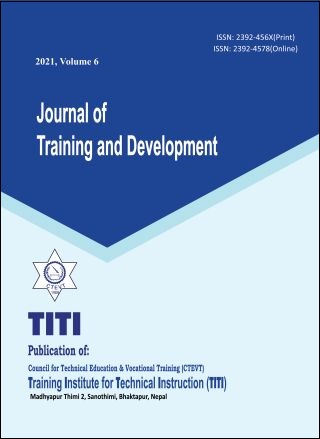Governing TVET in Federal Nepal: Centralized or Decentralized Management ?
DOI:
https://doi.org/10.3126/jtd.v6i01.41775Keywords:
Centralist mentality, Decentralization, Federal Nepal, Policy Implementation, TVET GovernanceAbstract
With the increasing recognition of the need for skilled human resources in developing countries, the role of technical and vocational education and training (TVET) has been an important part of the education system. However, in spite of such a vital role of TVET, challenges exist in designing, planning and implementing it while governing effectively. Such context has raised the issue of governing TVET among educationists, policy makers and all stakeholders to achieve its intended goals. The TVET governing issue has been of serious concern to its stakeholders in Nepal with the introduction of the federal structure in 2015. Hence this paper aims to explore the governing issue of TVET in the context of federal governance of Nepal. For this, this paper employs qualitative research approach in analyzing policy and practice of TVET in Nepal. This paper explores that the process of governing TVET in Nepal has remained highly centralized in spite of rhetoric of decentralization as the main agenda of governing development over the decades. Arguably, there is a reluctant tendency in devolving TVET as per the new structure of federal governance. Instead, conflicts among three levels of governments – federal, provincial and local – are emerging in the case of TVET similar to other development sectors. Hence, for sustainable operation and management of TVET this paper argues that the policy and practice of the TVET need to be guided by the concept of multilevel governance with collaboration among the three levels of government as envisaged by the new federal constitution.
Downloads
Downloads
Published
How to Cite
Issue
Section
License
Copyright (c) 2021 Thakur Prasad Bhatta

This work is licensed under a Creative Commons Attribution 4.0 International License.
Authors who publish with this journal agree to the following terms:
- Authors retain copyright and grant the journal right of first publication with the work simultaneously licensed under a Creative Commons Attribution License that allows others to share the work with an acknowledgement of the work's authorship and initial publication in this journal.
- Authors are able to enter into separate, additional contractual arrangements for the non-exclusive distribution of the journal's published version of the work (e.g., post it to an institutional repository or publish it in a book), with an acknowledgement of its initial publication in this journal.
- Authors are permitted and encouraged to post their work online (e.g., in institutional repositories or on their website) prior to and during the submission process, as it can lead to productive exchanges, as well as earlier and greater citation of published work (See The Effect of Open Access).




